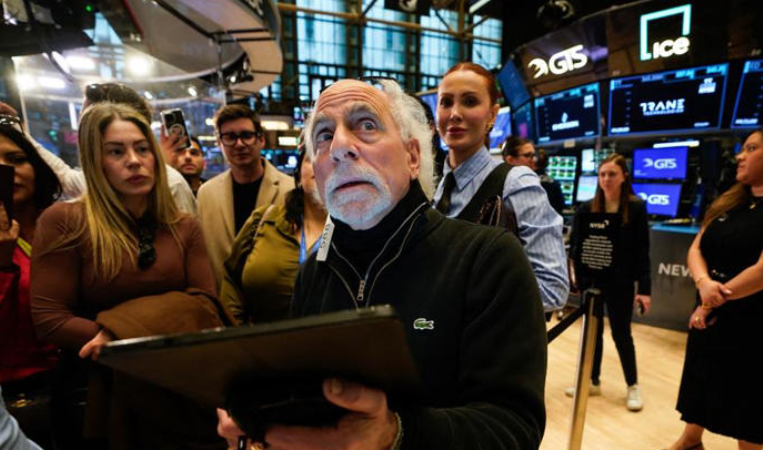S&P 500 Sinks to Six-Month Low as Trump Dismisses Market Volatility
- quinnvaras
- Mar 10
- 3 min read

Market Selloff Deepens Amid Tariff Concerns and Economic Uncertainty
The stock market continued its downward trajectory on Monday, driven by growing concerns over economic stability and shifting trade policies from the Trump administration. Investors reacted negatively to President Donald Trump’s latest comments, which failed to reassure Wall Street as fears of a potential recession gained traction.
Key Market Movements
The Dow Jones Industrial Average (DJI) fell 1.2%, shedding approximately 500 points by midday.
The S&P 500 (GSPC) declined 2.1%, reaching its lowest level since mid-September.
The Nasdaq Composite (IXIC) dropped 3.4%, officially entering correction territory with a 12% decline since February 19.
These declines erased Friday’s brief market rebound, reinforcing a persistent trend of volatility in recent weeks.
Trump’s Comments Exacerbate Investor Fears
A key catalyst for Monday’s selloff was Trump’s interview with Fox News’ Sunday Morning Futures, where he declined to rule out a potential recession and warned that the economy was undergoing a "transition" period. He further advised Americans against closely watching the stock market, which many investors interpreted as a signal of continued uncertainty and instability.
“Trump’s comments are weighing on sentiment and did nothing to ease investor concerns about ongoing policy chaos,” noted Tom Essaye, founder of the Sevens Report.
Nasdaq Plunges Into Correction Territory
The Nasdaq Composite has led the recent declines, with its 12% drop from the February 19 peak marking a definitive correction. The S&P 500 has also suffered, falling 8% over the same period, while the Dow Jones has lost 5%, equating to a 2,200-point decline.
The S&P 500 is now coming off its worst week since September, with last week’s 3.1% decline reinforcing concerns that the broader market is struggling under policy uncertainties and economic headwinds.
Big Tech Stocks Suffer the Largest Losses
Technology stocks, particularly in the artificial intelligence and electric vehicle sectors, have taken the brunt of the market downturn. Nvidia (NVDA) saw a 5% drop on Monday, extending its losses to 23% since February 19. Tesla (TSLA) plunged 9% on Monday, bringing its total loss over the same period to 34%.
Other tech giants also faced significant losses:
Apple (AAPL): -5%
Alphabet (GOOGL): -5%
Meta (META): -5%
Investors have increasingly rotated out of high-growth technology stocks, seeking safer assets amid market uncertainty.
Why the Market Is Falling
The recent market turmoil has coincided with Trump’s implementation of new tariffs, which have historically been negative for stocks as they increase corporate costs and dampen consumer demand. Beyond their direct economic impact, the uncertainty surrounding Trump’s tariff policies—including frequent changes in timing and targeted goods—has significantly unsettled investors.
“The reason stocks are dropping is the spike in uncertainty and fear that uncertainty will lead to a whole host of negatives,” Essaye explained.
The renewed fear of a U.S. recession has also become a dominant theme. On Friday, Goldman Sachs raised its recession probability to 20%, up from 15%, citing risks associated with Trump’s trade policies.
Contrasting Views: A Long-Term Market Outlook
Despite the current volatility, some analysts maintain a bullish long-term view. Morgan Stanley’s chief strategist, Michael Wilson, reaffirmed his 6,500 price target for the S&P 500 by the end of 2025. This forecast suggests a potential 15% gain from Monday’s 5,650 level.
Wilson expects Trump’s trade policies to have an initial negative impact on growth but believes that lower interest rates and more favorable corporate policies could stimulate the market later in the year.
Conclusion
The stock market continues to struggle amid mounting concerns over tariffs, economic slowdown fears, and increased volatility stemming from the Trump administration’s policy shifts. With the Nasdaq now in correction territory and Big Tech leading the declines, investors remain cautious as uncertainty looms. Looking ahead, market participants will closely monitor upcoming economic data and further policy developments to gauge whether the current downturn will deepen or if recovery signals begin to emerge.







Comments